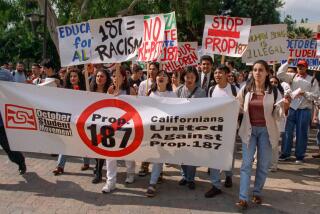No Longer So Counted Out : Census Bureau agrees to new procedure for adding up Asians
- Share via
For the first time since 1860 when the Census Bureau began counting Asians in the United States, the federal government is finally making a long-overdue effort to get a more accurate measure of America’s fastest-growing ethnic group.
The Census Bureau recently disclosed it will break out Asians as a distinct category in data recently collected to adjust for undercounts of minorities in the 1990 Census. This change is particularly important to western states, especially California, where Asian and Pacific Islanders account for about 9.5% of the state’s population.
Federal officials routinely conduct what is called a “post-enumeration survey” after the formal census is completed. The purpose of the survey is to identify undercounts in states and big cities. Asian-American activists had voiced strong objections to the Census Bureau’s original decision in June to confine undercount efforts to three categories: blacks, non-black Hispanics and all others. The bureau initially argued that Asians and Pacific Islanders compose such a small percentage of the total U.S. population--about 3%--that an undercount would not be detected.
But that was wrong. Census officials changed their tune after they found that the recently completed survey of 150,000 households nationwide yielded a larger sample of Asian and Pacific Island households than expected.
The survey will help identify undercounts of these groups in California, Oregon, Washington, Alaska and Hawaii, as well as New York City. These counts are crucial in ensuring that Asians get their fair share--particularly in federal funding and in representation in Congress.
The 1980 Census significantly undercounted minorities: almost 10% of the Latino community; 9% of African-Americans and 7% of Asians. The new efforts should narrow such discrepancies. Now it’s up to the secretary of commerce to go ahead and incorporate the undercount data in the final 1990 Census report. He should.
More to Read
Get the L.A. Times Politics newsletter
Deeply reported insights into legislation, politics and policy from Sacramento, Washington and beyond. In your inbox three times per week.
You may occasionally receive promotional content from the Los Angeles Times.










